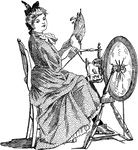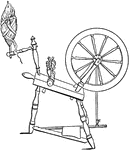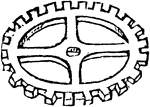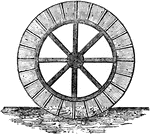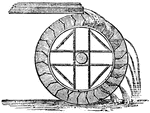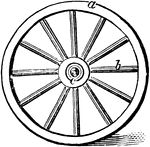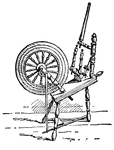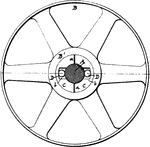
Pulley
A pulley, also called a sheave or a drum, is a mechanism composed of a wheel on an axle or shaft that…

Turning Belt Pulleys
"The pulley is first put in a revolver lathe and there bored and reamed, while on edge of the rim is…

Quarter Clock
"The front view of a large quarter clock of Sir E. Beckett's design, with all the wheels on the great…
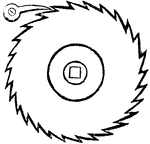
Ratchet-wheel
"A circular wheel, with teeth on the circumference, by which it can be moved or its motion stayed."…
Roller
A roller. Crushes clods and packs the surface so as to keep the seed moist at the expense of increased…
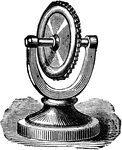
Savart wheel
"The Savart wheel consists of a heavy metal toothed wheel that may be put in rapid revolution by pulling…
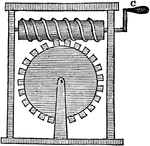
Screw and Wheel
"It is apparent by turning the crank, C, the wheel will revolve, for the thread of the screw passes…

Scutcher
"Scutching-machine or Scutcher for Flax. a, feed-table on which the flax is fed to the fluted rollers…

Wheeler and Wilson Sewing Machine
"a, is the frame; b, shaft-crank which rocks the hook-shaft; e, receiving its motion from the double…
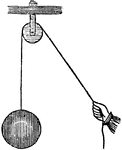
Simple Pulley
"...represents a simple pulley, with a single fixed wheel. In other forms of the machine, the wheel…

Wing Snow Plow
"An implement for clearing away snow from roads, railways, etc. a, body of plow; b, caboose for implements…

A Spinning Wheel
"A band or cord (E) connected the large wheel with the small wheel (D). Another cord (F) connected the…
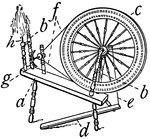
Spinning Wheel for Flax
"A machine for spinning flax into threads by hand. It consists of a wheel, band, and spindle, and is…

Spinning Wheel for Wool
"A machine for spinning flax into threads by hand. It consists of a wheel, band, and spindle, and is…
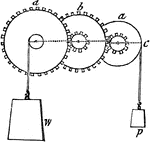
System of Wheels
"System of Wheels.—As the wheel and axle is only a modification of the simple lever, so a system…

Tantalus, Sisyphus, and Ixion
"As he sang these tender strains, the very ghosts shed tears. Tantalus, in spite of his thirst, stopped…

Adjustable Tire
A tire is ring shaped, the earliest tires were bands of iron placed on wooden wheels which were used…

Elastic Tire
A tire is a ring shaped covering that fits around a wheel to protect it and enable better vehicle performance…

Turbine
"The most efficient form of water-wheel is the turbine, one form of which is shown." — Avery,…
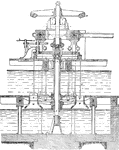
Girard Turbine
"The general sectionl elevation of a Girard turbine, in which the flow is axial. The water, admitted…
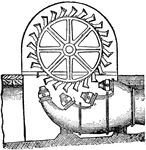
Pelton Wheel Turbine
"Turbine is, in mechanics, a term formerly confined to horizontal water wheels, the revolution of which…
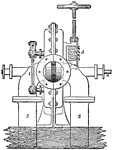
Reaction Turbine
"Professor James Thomson's inward flow or vortex turbine has been selected as the type of reaction turbines.…
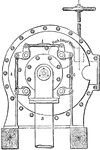
Reaction Turbine
"Professor James Thomson's inward flow or vortex turbine has been selected as the type of reaction turbines.…

Reaction Turbine
"Professor James Thomson's inward flow or vortex turbine has been selected as the type of reaction turbines.…
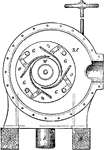
Reaction Turbine
"Professor James Thomson's inward flow or vortex turbine has been selected as the type of reaction turbines.…
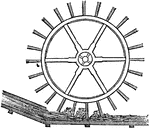
Undershot Wheel
"Thus constructed, this wheel moves equally well whether the water acts on one or the other side of…
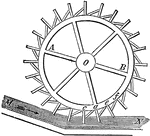
Undershot Wheel
"Waterwheel where the lowest flat-board is submerged in the running water. The water is often given…
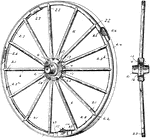
Antique Vehicle Wheel
A wheel is a circular device that is capable of rotating on its axis, facilitating movement or transportation…
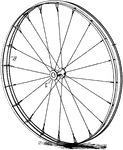
Side View of a Vehicle Wheel
A wheel is a circular device that is capable of rotating on its axis, facilitating movement and transportation.
!["[This illustration] shows a third form of the wheel and axle. Here the axle A is vertical, instead of horizontal. A bar inserted in its head, at the extremity of which the hand is applied, takes the place of the wheel." —Quackenbos 1859](https://etc.usf.edu/clipart/36300/36346/vert_whax_36346_mth.gif)
Vertical Wheel and Axle
"[This illustration] shows a third form of the wheel and axle. Here the axle A is vertical, instead…

Water Wheel
"When a water fall ranges between 10 and 70 feet, and the water supply is from 3 to 25 cubic feet per…
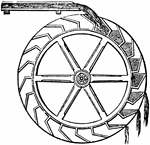
Water-wheel
"A wheel driven by water shot over the top. The buckets of the wheel receive the water as nearly as…
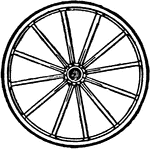
Wheel
A wheel is a circular device that is capable of rotating on its axis, facilitating movement or transportation.
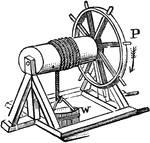
Wheel and axle
"The wheel and axle consists of a wheel united to a cylinder in such a way that they may turn together…

Wheel and Axle
"The wheel and axle consists of two cylinders of different diameters, rigidly connected, so that they…
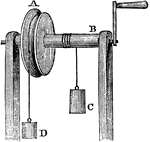
Wheel and Axle
"It consists of two wheels, one of which is larger than the other, but the small one passes through…
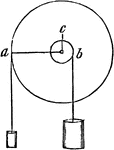
Wheel and Axle
"This figure represents the machine endwise, so as to show in what manner the lever operates. The two…

Wheel and Axle
"To change the direction, it is only necessary that the rope by which the weight is to be raised, should…
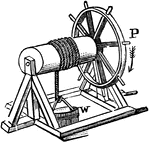
Wheel and Axle with Rope and Bucket
"The wheel and axle consists of a wheel united to a cylinder in such a way that they may turn together…
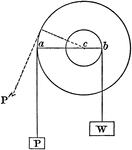
Wheel and Axle
"Considered as a lever, the fulcrum is at the common axis, while the arms of the lever are the radii…

Wheel and Axle with Rope and Bucket
"...the mechanical advantage of this machine (wheel and axle) equal the ratio between the radii, diameters,…
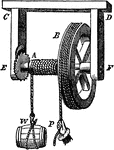
Wheel and Axle
"The wheel and axle is simply a revolving lever of the first kind. One application of the lever can…
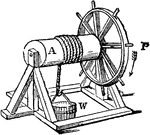
Wheel and Axle with Spokes
"Instead of having a rope attached to it, the wheel is often provided with projecting pins, as shown,…
Wheel Barometer
"The whole length of the tube of the wheel barometer, from C to A, is 34 or 35 inches, and it is filled…
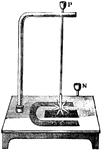
Wheel Rotation
"Rotation of a Wheel. The same force which throws the wire away from the mercury, will cause the rotation…
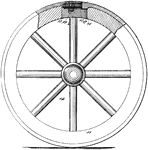
Rubber Made Wheel Tire
A tire is a ring shaped covering that fits around a wheel to protect it and enable better vehicle performance…
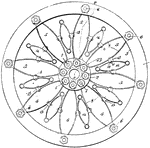
Eight Spoke Wheel
A wheel is a circular device that is capable of rotating on its axis, facilitating movement or transportation…

Overshot wheel
"In the overshot wheel, the water falls into buckets at the top, and by its weight, aided by the force…
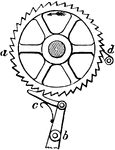
Ratchet Wheel
A wheel with pointed and angular teeth, against which a ratchet abuts, used either for converting a…
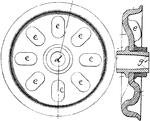
Sheet Metal Web Wheel
A circular frame of hard material that may be solid, partly solid, or spoked and that is capable of…

